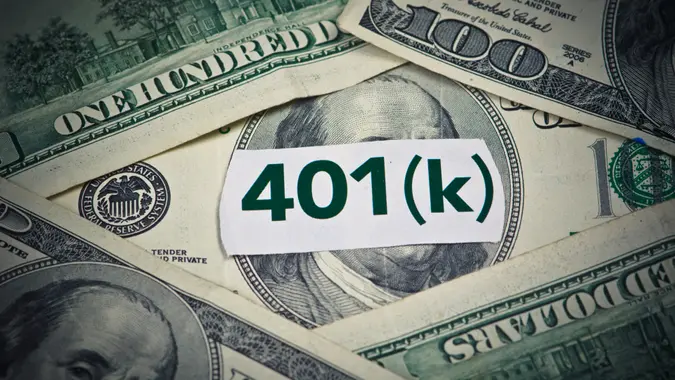How Retirees Can Save Money and Protect Their Pensions From Trump’s Tariffs

Commitment to Our Readers
GOBankingRates' editorial team is committed to bringing you unbiased reviews and information. We use data-driven methodologies to evaluate financial products and services - our reviews and ratings are not influenced by advertisers. You can read more about our editorial guidelines and our products and services review methodology.

20 Years
Helping You Live Richer

Reviewed
by Experts

Trusted by
Millions of Readers
The first weeks of April were an unwelcome and unsettling financial roller coaster ride for retirees heavily invested in stocks.
President Donald Trump has since retracted some of the “Liberation Day” tariffs that triggered the ongoing stock market melee, but there’s widespread worry that those very policy inconsistencies could trigger more turmoil in the coming weeks and months.
If the losses are steep enough, retirees or those approaching retirement might not have enough time to see their holdings ever recover. Here’s how they can prepare now by readying their portfolios for what could be troubled waters ahead.
Offload Some of Your Holdings To Create a Cash Buffer
According to Barron’s, most retirees should maintain a cash cushion of one to two years’ worth of withdrawals. The amount, which varies by retiree, is enough to cover basic expenses after factoring in Social Security benefits and other income.
This cash buffer is crucial, because it allows retirees to endure even intense periods of volatility without selling stocks at a loss. Bear markets are defined as periods where the market declines by at least 20%. Historically, they last only between nine and 10 months before the market rebounds and heads back toward bull territory. That makes 12 to 24 months of cash savings more than enough to get by without selling in the red.
Use Surges as Opportunities To Sell
If you don’t have liquid savings, don’t do anything rash — panic selling during downturns is almost always a losing bet.
Emotional investors who sold out of fear during the fast and terrifying wipeouts that followed Trump’s tariff announcements missed the best day in market history. When the president retracted most of his yet-unimplemented import duties, the S&P 500 tallied a record single-day gain of 474 points when U.S. stocks piled on an unprecedented $5.1 trillion in market value in one trading session.
These surges — which occur periodically during every bear market — offer an opportunity to cut your losses or even harvest some gains, even if the next surge isn’t so dramatic.
Do What You Were Supposed To Do Before Retirement — Reduce Your Risk Exposure
Young people can keep piling onto their Nasdaq ETFs because they have the years needed to recover from the disproportionately high losses they incur when the market sours — but if they were smart, they’d choose target-based funds that ween them off that risk automatically over time.
Most experts recommend gradually shifting away from higher-risk, higher-reward bets like equities in favor of safer vehicles like bonds before retirement. If you haven’t reallocated your assets yet, now is the time.
The right mix of stocks and bonds is different for every retiree, but base your strategy on one undeniable reality: Risk becomes riskier the longer you live. According to Charles Schwab, the following guidelines offer a good starting point.
- 60 to 69: Young retirees should consider a moderate-risk portfolio of 5% cash or cash investments, 35% bonds and 60% stocks.
- 70 to 79: This intermediate age calls for a moderately conservative mix of 10% cash or cash investments, 40% stocks and 50% bonds.
- 80 and older: Choose conservative blends of 20% stocks, 30% cash or cash investments and 50% bonds.
Leverage the Silver Lining of Tax Advantages
The bright side is that tumultuous times give investors an unlikely ally: the IRS.
Just as the Treasury Department wants to know about your capital gains so it can take its cut from your earnings, retirees can work that dynamic in their favor by strategically selling when they’re down to reduce their taxable income.
Deliberately selling undesirable equities at a loss in a single year is called tax-loss harvesting, and, according to CNBC, the strategy was designed for moments like the present.
Another option is Roth conversions, which allow investors to settle up with the IRS for previous untaxed growth so they can start enjoying tax-free appreciation when the inevitable market recovery brings sunnier days.
Editor’s note on political coverage: GOBankingRates is nonpartisan and strives to cover all aspects of the economy objectively and present balanced reports on politically focused finance stories. You can find more coverage of this topic on GOBankingRates.com.
 Written by
Written by  Edited by
Edited by 

























